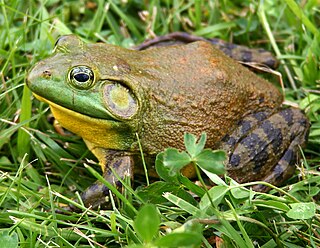 W
WThe American bullfrog, often simply known as the bullfrog in Canada and the United States, is a large true frog native to eastern North America. It typically inhabits large permanent water bodies such as swamps, ponds, and lakes. Bullfrogs can also be found in man made habitats such as pools, koi ponds, canals, ditches and culverts. The bullfrog gets its name from the sound the male makes during the breeding season, which sounds similar to a bull bellowing. The bullfrog is large and is commonly eaten throughout its range, especially in the southern United States where they are plentiful.
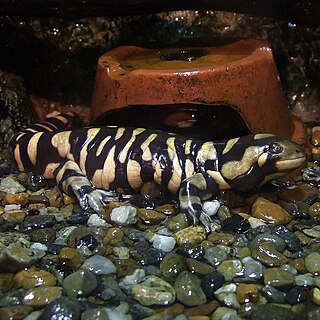 W
WThe barred tiger salamander or western tiger salamander is a species of mole salamander found from southwestern Canada in British Columbia, Alberta, Saskatchewan, and Manitoba, south through the western United States to Texas and northern Mexico.
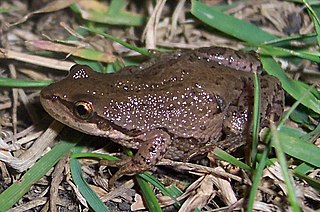 W
WThe boreal chorus frog is a species of chorus frog native to Canada from central Quebec to eastern British Columbia and north to the Northwest Territories and the southern portion of the Yukon Territory. It occurs in the USA throughout Montana, northwestern Wisconsin, northeastern Arizona, northern New Mexico, and southwestern Utah.
 W
WThe Canadian toad is a species of toad that ranges from the prairie regions of central Canada south to parts of the United States upper midwest. It belongs to the family Bufonidae, the "true" toads. Its specific name is derived from the Latin word hemiophrys, meaning eyebrow, which refers to its pronounced cranial crest between and behind the eye. Anaxyrus hemiophrys displays the typical toad characteristics, they lack a tail and teeth, they have horizontal pupils and their dry skin is thick and warty.
 W
WThe coastal giant salamander is a species of salamander in the family Ambystomatidae. It is endemic to the Pacific Northwest of North America. There are three closely related species to this taxon: D. ensatus, D. copei, and D. aterrimus.
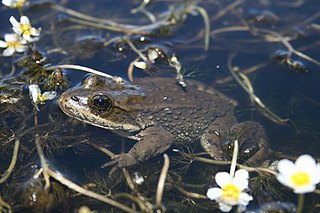 W
WThe Columbia spotted frog is a North American species of frog. It is green to brown in color with spots on the dorsal surface. The belly and upper lip are white in color. Individuals can be distinguished from other Rana species by their shorter back legs, narrow snout, and upturned eyes. Since they spend most of their time in the water, they also have more webbing in their hind feet than similar species. Although not threatened, this animal has been studied as a model species for the effects of habitat fragmentation.
 W
WThe common mudpuppy is a species of salamander in the genus Necturus. They live an entirely aquatic lifestyle in the eastern part of North America in lakes, rivers, and ponds. They go through paedomorphosis and retain their external gills. Because skin and lung respiration alone is not sufficient for gas exchange, mudpuppies must rely on external gills as their primary means of gas exchange. They are usually a rusty brown color and can grow to an average length of 33 cm (13 in). Mudpuppies are nocturnal creatures, and come out during the day only if the water in which they live is murky. Their diet consists of almost anything they can get in their mouths, including insects, mollusks, and earthworms. Once a female mudpuppy reaches sexual maturity at six years of age, she can lay an average of 60 eggs. In the wild, the average lifespan of a mudpuppy is 11 years.
 W
WDesmognathus fuscus is a species of amphibian in the family Plethodontidae. The species is commonly called the dusky salamander or northern dusky salamander to distinguish it from populations in the southern United States which form a separate species, the southern dusky salamander. The northern dusky salamander is the most widespread representative of its genus in Canada. It can be found in eastern North America from extreme eastern Canada in New Brunswick south into the panhandle of Florida and west to Louisiana. The size of the species' total population is unknown, but is assumed to easily exceed 100,000. The species' habitat differs somewhat geographically; dusky salamanders in the northern part of the range prefer rocky woodland streams, seepages, and springs, while those in the south favor floodplains, sloughs, and muddy places along upland streams. They are most common where water is running or trickling. They hide under various objects, such as leaves or rocks, either in or near water. Alternatively, they may enter burrows for protection. The dusky salamander lays its eggs close to water under moss or rocks, in logs, or in stream-bank cavities. The larval stage which follows is normally aquatic.
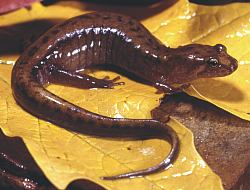 W
WThe Allegheny Mountain dusky salamander is a species in the Plethodontidae family. It is found in the eastern United States and southern Quebec, Canada. Its natural habitats are temperate forests, rivers, intermittent rivers, freshwater springs, and rocky areas.
 W
WThe mink frog is a small species of frog native to the United States and Canada. They are so named for their scent, which reportedly smells like a mink. The scent is more akin to that of rotting onions to those unfamiliar with mink. It is also sometimes referred to as the north frog.
 W
WThe northern leopard frog is a species of leopard frog from the true frog family, native to parts of Canada and the United States. It is the state amphibian of Minnesota and Vermont.
 W
WThe western chorus frog, also known as striped chorus frog, or midland chorus frog is a species of frog found in Canada and the United States.
 W
WThe gray treefrog is a species of small arboreal holarctic tree frog native to much of the eastern United States and southeastern Canada.
 W
WThe spring salamander is a species of salamander in the family Plethodontidae It is found in Canada and the United States. The generic name, Gyrinophilus, means "tadpole lover" and refers to the long period of time it spends as a gilled larva before maturing. The specific name, porphyriticus, is Latin from Greek, meaning the color of porphyry, a purple stone, and this salamander has also been called the purple salamander.
 W
WThe long-toed salamander is a mole salamander in the family Ambystomatidae. This species, typically 4.1–8.9 cm (1.6–3.5 in) long when mature, is characterized by its mottled black, brown, and yellow pigmentation, and its long outer fourth toe on the hind limbs. Analysis of fossil records, genetics, and biogeography suggest A. macrodactylum and A. laterale are descended from a common ancestor that gained access to the western Cordillera with the loss of the mid-continental seaway toward the Paleocene.
 W
WThe eastern newt is a common newt of eastern North America. It frequents small lakes, ponds, and streams or nearby wet forests. The eastern newt produces tetrodotoxin, which makes the species unpalatable to predatory fish and crayfish. It has a lifespan of 12 to 15 years in the wild, and it may grow to 5 in (13 cm) in length. These animals are common aquarium pets, being either collected from the wild or sold commercially. The striking bright orange juvenile stage, which is land-dwelling, is known as a red eft. Some sources blend the general name of the species and that of the red-spotted newt subspecies into the eastern red-spotted newt.
 W
WThe northern green frog is a subspecies of the green frog, Lithobates clamitans. It is native to the northeastern North America and has been introduced to British Columbia. Its mating call sounds like the single note of a plucked banjo. It is also quite common in the pet trade.
 W
WThe northern red-legged frog is a species of amphibian, whose range is the coastal region stretching from southwest British Columbia to southern Mendocino County in Northern California, and is protected in Oregon and California. As a member of the genus Rana, this species is considered a true frog, with characteristic smooth skin and a narrow waist. This frog requires still waters for breeding, and is rarely found at any great distance from its breeding ponds or marshes.
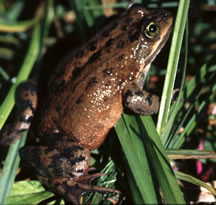 W
WThe Oregon spotted frog is a member of the frog family Ranidae of order Anura. It is a medium-sized aquatic frog endemic to the Pacific Northwest and historically well distributed in the Puget Trough/Willamette Valley province and the Cascade Mountains of south-central Washington and Oregon. It is relatively rare within its range and is listed globally as vulnerable.
 W
WThe Pacific tree frog, also known as the Pacific chorus frog, has a range spanning the Pacific Northwest, from Northern California, Oregon, and Washington to British Columbia in Canada and extreme southern Alaska. They live from sea level to more than 10,000 feet in many types of habitats, reproducing in aquatic settings. They occur in shades of greens or browns and can change colors over periods of hours and weeks.
 W
WThe pickerel frog is a small North American frog, characterized by the appearance of seemingly "hand-drawn" squares on its dorsal surface.
 W
WThe northern leopard frog is a species of leopard frog from the true frog family, native to parts of Canada and the United States. It is the state amphibian of Minnesota and Vermont.
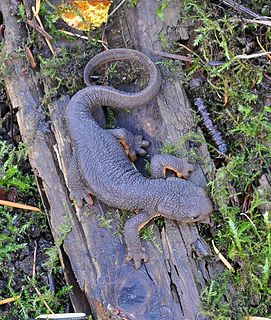 W
WThe rough-skinned newt or roughskin newt is a North American newt known for the strong toxin exuded from its skin.
 W
WThe Allegheny Mountain dusky salamander is a species in the Plethodontidae family. It is found in the eastern United States and southern Quebec, Canada. Its natural habitats are temperate forests, rivers, intermittent rivers, freshwater springs, and rocky areas.
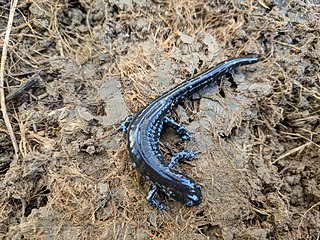 W
WThe blue-spotted salamander is a mole salamander native to the Great Lakes states and northeastern United States, and parts of Ontario and Quebec in Canada. Their range is known to extend to James Bay to the north, and southeastern Manitoba to the west.
 W
WThe four-toed salamander is a lungless salamander native to eastern North America. It is the only species of the monotypic genus Hemidactylium.
 W
WThe Jefferson salamander is a mole salamander native to the northeastern United States, southern and central Ontario, and southwestern Quebec. It was named after Jefferson College in Pennsylvania.
 W
WDesmognathus fuscus is a species of amphibian in the family Plethodontidae. The species is commonly called the dusky salamander or northern dusky salamander to distinguish it from populations in the southern United States which form a separate species, the southern dusky salamander. The northern dusky salamander is the most widespread representative of its genus in Canada. It can be found in eastern North America from extreme eastern Canada in New Brunswick south into the panhandle of Florida and west to Louisiana. The size of the species' total population is unknown, but is assumed to easily exceed 100,000. The species' habitat differs somewhat geographically; dusky salamanders in the northern part of the range prefer rocky woodland streams, seepages, and springs, while those in the south favor floodplains, sloughs, and muddy places along upland streams. They are most common where water is running or trickling. They hide under various objects, such as leaves or rocks, either in or near water. Alternatively, they may enter burrows for protection. The dusky salamander lays its eggs close to water under moss or rocks, in logs, or in stream-bank cavities. The larval stage which follows is normally aquatic.
 W
WThe small-mouth salamander is a species of mole salamander found in the central United States, from the Great Lakes region in Michigan to Nebraska, south to Texas, and east to Tennessee, with a population in Canada, in Pelee, Ontario. It is sometimes referred to as the Texas salamander, porphyry salamander, or the narrow-mouthed salamander. The Kelley's Island salamander was synonymized with A. texanum in 1995.
 W
WThe northern two-lined salamander is a species of salamander in the family Plethodontidae found in Canada and the United States. Its natural habitats are temperate forests, temperate shrubland, rivers, intermittent rivers, freshwater marshes, freshwater springs, arable land, and urban areas. It is more water-oriented than the related northern redback salamander, and can often be found in and around water such as rain puddles, streams, swamps, and damp stream beds, whereas the northern redback tends to be found in damp ground, but usually not near open water.
 W
WThe red-backed salamander is a species of small, hardy woodland salamander in the family Plethodontidae. The species inhabits wooded slopes in eastern North America, west to Missouri, south to North Carolina, and north from southern Quebec and the Maritime provinces in Canada to Minnesota. It is also known as the redback salamander, eastern red-backed salamander, or the northern red-backed salamander to distinguish it from the southern red-backed salamander. It is one of 56 species in the genus Plethodon.
 W
WThe spotted salamander or yellow-spotted salamander is a mole salamander common in eastern United States and Canada. The spotted salamander is the state amphibian of Ohio and South Carolina. This salamander ranges from Nova Scotia, to Lake Superior, to southern Georgia and Texas. Its embryos have been found to have symbiotic algae living inside them, the only known example of vertebrate cells hosting an endosymbiont microbe.
 W
WThe spring salamander is a species of salamander in the family Plethodontidae It is found in Canada and the United States. The generic name, Gyrinophilus, means "tadpole lover" and refers to the long period of time it spends as a gilled larva before maturing. The specific name, porphyriticus, is Latin from Greek, meaning the color of porphyry, a purple stone, and this salamander has also been called the purple salamander.
 W
WThe tiger salamander is a species of mole salamander and one of the largest terrestrial salamanders in North America.
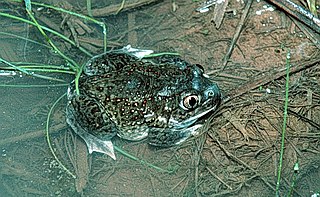 W
WThe plains spadefoot toad is a species of American spadefoot toad which ranges from southwestern Canada, throughout the Great Plains of the western United States, and into northern Mexico. Like other species of spadefoot toads, they get their name from a spade-like projections on their hind legs which allow them to dig into sandy soils. Their name, in part, comes from their keratinized metatarsals, which are wide instead of "sickle shaped". The species name translates as buzzing leaf shaped. This refers to the species distinguishing features; its buzzing mating call, and its leaf-shaped digging metatarsals. First described by Cope in 1863.
 W
WThe spring peeper is a small chorus frog widespread throughout the eastern United States and Canada. They are so called because of their chirping call that marks the beginning of spring. There are two subspecies:The northern, P. c. crucifer, found all over the eastern United States and eastern Canada. The southern, P. c. bartramiana. The southern is distinguished by a strong dark marking on its belly. P. c. bartramiana is found along the southern Gulf Coast from southeastern Texas to northern Florida and southern Georgia.
 W
WThe tailed frogs are two species of frogs in the genus Ascaphus, the only taxon in the family Ascaphidae. The "tail" in the name is actually an extension of the male cloaca. The tail is one of two distinctive anatomical features adapting the species to life in fast-flowing streams. These are the only North American frog species that reproduce by internal fertilization.
 W
WThe American toad is a common species of toad found throughout the eastern United States and Canada. It is divided into three subspecies—the eastern American toad, the dwarf American toad, and the rare Hudson Bay toad. Recent taxonomic treatments place this species in the genus Anaxyrus instead of Bufo.
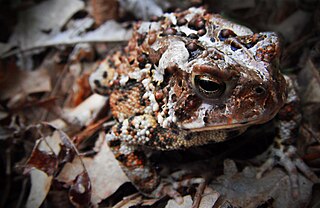 W
WFowler's toad is a species of toad in the family Bufonidae. The species is native to North America, where it occurs in much of the eastern United States and parts of adjacent Canada. It was previously considered a subspecies of Woodhouse's toad.
 W
WThe Great Plains toad, Anaxyrus cognatus, is a relatively large species of true toad native to central North America.
 W
WThe plains spadefoot toad is a species of American spadefoot toad which ranges from southwestern Canada, throughout the Great Plains of the western United States, and into northern Mexico. Like other species of spadefoot toads, they get their name from a spade-like projections on their hind legs which allow them to dig into sandy soils. Their name, in part, comes from their keratinized metatarsals, which are wide instead of "sickle shaped". The species name translates as buzzing leaf shaped. This refers to the species distinguishing features; its buzzing mating call, and its leaf-shaped digging metatarsals. First described by Cope in 1863.
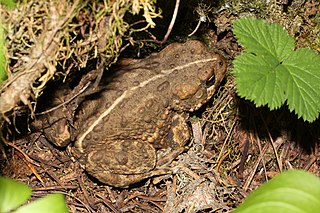 W
WThe western toad is a large toad species, between 5.6 and 13 cm long, native to western North America. A. boreas is frequently encountered during the wet season on roads, or near water at other times. It can jump a considerable distance for a toad. Breeding occurs between March and July in mountainous areas, and as early as January in lower-elevation regions. The female lays up to 17,000 eggs stuck together in strings that adhere to vegetation and other objects along water edges.
 W
WThe wood frog has a broad distribution over North America, extending from the boreal forest of the north to the southern Appalachians, with several notable disjunct populations including lowland eastern North Carolina. The wood frog has garnered attention by biologists over the last century because of its freeze tolerance, relatively great degree of terrestrialism, interesting habitat associations, and relatively long-range movements.